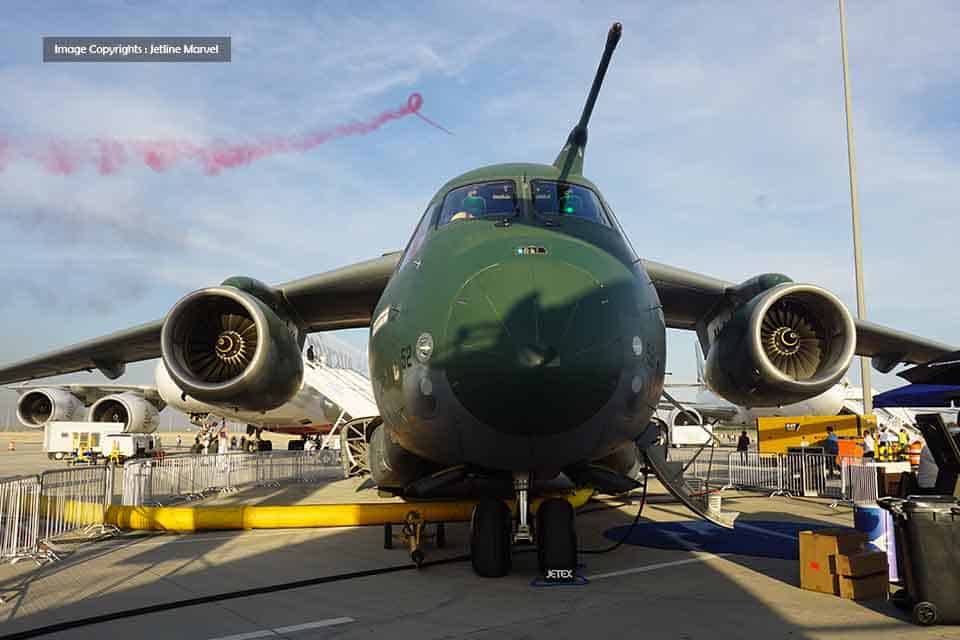Aerospace
South Korea selects the Embraer C-390 Millennium

C-390 is the winner of LTA-II program public tender to provide the Republic of Korea Air Force with new military transport aircraft. The country will be Asia’s first C-390 Millennium operator
Seoul, South Korea, December 04, 2023 – South Korea’s Defense Acquisition Program Administration (DAPA) has announced Embraer’s C-390 Millennium as the winner of the Large Transport Aircraft (LTA) II public tender to provide the Republic of Korea Air Force (ROKAF) with new military transport aircraft. South Korea is the C-390 Millennium’s first customer in Asia.
Per the finalized contract, Embraer is set to deliver an undisclosed number of C-390 Millennium aircraft meticulously tailored to meet the specific requirements of the ROKAF. The agreement extends beyond the aircraft itself, encompassing a spectrum of services and support, including training, ground support equipment, and spare parts. The financial value associated with this contract will be integrated into Embraer’s backlog during the final quarter of 2023.
The package includes a substantial allocation of C-390 Millennium components
In addition to the aircraft delivery, Embraer is committed to providing a comprehensive consortium and offset package. This package includes a substantial allocation of C-390 Millennium components to be produced locally by Korean partner companies. Furthermore, it involves the establishment of a local Maintenance Repair and Overhaul (MRO) provider.
Bosco da Costa Jr., President and CEO of Embraer Defense & Security, expressed enthusiasm, stating, “We welcome the Republic of Korea Air Force to the growing number of air forces operating the C-390 Millennium – the most modern military tactical transport aircraft.” Da Costa emphasized the aircraft’s consistent performance in various missions, highlighting its efficiency, serviceability, and speed. He also emphasized the collaborative commitment between Brazil and South Korea to enhance the capabilities of their aerospace and defense industries.
South Korea’s decision to opt for the C-390 Millennium makes it the seventh nation to choose this aircraft, following Brazil, Portugal, Hungary, the Netherlands, Austria, and the Czech Republic. Renowned for redefining military airlift, the C-390 challenges conventional perspectives on current and future-generation platforms. Its design incorporates multi-mission capability, reliability, and interoperability.
Since its operational debut with the Brazilian Air Force in 2019 and, more recently, with the Portuguese Air Force in 2023, the C-390 has consistently demonstrated its capacity, reliability, and performance. The existing fleet has amassed over 10,800 flight hours, showcasing an operational availability of approximately 80% and mission completion rates exceeding 99%, underscoring exceptional productivity within its category.
C-390 Payload capacity of 26 tons
Distinguishing itself from medium-sized military transport aircraft, the C-390 boasts an impressive payload capacity of 26 tons and a higher flying speed at 470 knots. Its versatility enables a broad spectrum of missions, including cargo and troop transport, medical evacuation, search and rescue, firefighting, and humanitarian endeavors. Notably, the aircraft can operate on temporary or unpaved runways, such as packed earth, soil, and gravel. Additionally, the version equipped with air-to-air refueling capabilities, designated as the KC-390, has already demonstrated its prowess both as a tanker and as a receiver during aerial refueling operations.

Aerospace
Boeing Transfers Rocket Stage to NASA, Paving Way for Human Moon Mission

Boeing has achieved a significant milestone by providing NASA with the second core stage of the Space Launch System (SLS) rocket.
This crucial component, crafted at NASA’s Michoud Assembly Facility (MAF), is set to propel the Artemis II crew into lunar orbit, marking humanity’s return to deep space after a 50-year hiatus.
The monumental Boeing-built rocket stage, the largest element of the Artemis II mission, will embark on a journey aboard the Pegasus barge, traveling 900 miles to NASA’s Kennedy Space Center.
Comparison of two legendary aircraft B777x vs B747 aircraft:Click here
Upon arrival, it will be meticulously integrated with other essential Artemis II components, including the upper stage, solid rocket boosters, and NASA’s Orion spacecraft within the iconic Vehicle Assembly Building. This intricate integration process is a vital step toward the eagerly anticipated Artemis II launch, slated for 2025.
“Boeing-built products helped land humankind on the moon in 1969, and we’re proud to continue that legacy through the Artemis generation,” remarked Dave Dutcher, vice president and program manager for Boeing’s SLS program. “Together, with NASA and our industry partners and suppliers, we are building the world’s most capable rocket and paving the way to deep space through America’s rocket factory in New Orleans.”
NASA, Lockheed Martin Reveal X-59 Quiet Supersonic Aircraft:Click here
The delivery of Core Stage 2 marks a significant achievement in the evolution of the SLS rocket. Towering over 200 feet and powered by four RS-25 engines, this core stage, coupled with two solid-fueled booster rockets, will generate a staggering 8.8 million pounds of thrust. This immense power is crucial to launching Artemis II and future missions into the vast expanse of space.
The SLS rocket stands unparalleled in its capability to transport both crew and substantial cargo to the moon and beyond in a single launch. Its extraordinary capacity will facilitate the delivery of human-rated spacecraft, habitats, and scientific missions to destinations including the moon and Mars, ushering in a new era of space exploration.
-

 Travel1 week ago
Travel1 week agoAir India to Expand US Operations with Three New Routes After a Decade
-

 Travel2 weeks ago
Travel2 weeks agoWhy We Should Avoid These Stamps in a Passport
-

 Airlines1 month ago
Airlines1 month agoInvestigations Reveal Fake Chinese Titanium in Boeing and Airbus Jets
-

 Tech4 weeks ago
Tech4 weeks agoChina’s CATL Plans 1,800-Mile Electric Plane Launch by 2027
-

 Airport3 days ago
Airport3 days agoTop 10 Largest Airports in the World by Size
-

 Aerospace4 weeks ago
Aerospace4 weeks agoChina’s Fighter Jets Turn Wings into Autonomous Drones
-

 Airlines4 days ago
Airlines4 days agoAir India Rolls Out A350s for Delhi-New York JFK and Newark Routes
-

 Defence3 weeks ago
Defence3 weeks agoBoeing Enhances Chinook with New Engines and Block II Upgrades at $96 Million







